Enhanced TDS
Identification & Functionality
- Chemical Family
- Fillers Included
- RTU Product Type
- Technologies
- Product Families
Features & Benefits
- Ready-to-Use Product Features
- Product Features
- Long pot-life, short geltime at higher temperature
- Excellent mechanical and electrical properties
- Excellent crack resistance
Applications & Uses
- Composites Processing Methods
- Cure Method
- Product End Uses
- Applications
Instrument transformers and dry type distribution transformer.
- System Preparation
General Instructions for Preparing Liquid Resin Systems:
- Long pot life is desirable in the processing of any Araldite® casting resin system. Mix all of the components together very thoroughly at room temperature or slightly above and under vacuum. Intensive wetting of the filler is extremely important. Proper mixing will result in:
- Better flow properties and reduced tendency to shrinkage.
- Lower internal stresses and therefore improved mechanical properties on object.
- Improved partial discharge behaviour in high voltage applications.
- For the mixing of medium- to highviscous Araldite® casting resin systems and for mixing at lower temperatures, we recommend special thin film degassing mixers that may produce additional self-heating of 10-15 K as a result of friction. For low viscous Araldite® casting resin systems, conventional anchor mixers are usually sufficient.
- The prefilled Araldite® resin and Aradur® hardener can be stored at slightly elevated temperature (lower than 60°C) for up to about 1 week, de-pending on formulation. Intermittent agitation during storage is advisable to prevent filler sedimentation.
- Mixing time can vary from 0.5 to 3 hours, depending on mixing temperature, quantity, mixing equipment and the particular application. The required vacuum is 0.5 to 8 mbar. The vapour pressure of the individual components should be taken into account.
- System Preparation
General instructions for preparing liquid resin systems:
- Long pot life is desirable in the processing of any Araldite® casting resin system. Mix all of the components together very thoroughly at room temperature or slightly above and under vacuum. Intensive wetting of the filler is extremely important. Proper mixing will result in:
- Better flow properties and reduced tendency to shrinkage
- Lower internal stresses and therefore improved mechanical properties on object
- Improved partial discharge behaviour in high voltage applications.
- For the mixing of medium- to highviscous Araldite® casting resin systems and for mixing at lower temperatures, we recommend special thin film degassing mixers that may produce additional self-heating of 10-15 K as a result of friction. For low viscous Araldite® casting resin systems, conventional anchor mixers are usually sufficient.
- The prefilled Araldite® resin and Aradur® hardener can be stored at slightly elevated temperature (lower than 60°C) for up to about 1 week, depending on formulation. Intermittent agitation during storage is advisable to prevent filler sedimentation.
- Mixing time can vary from 0.5 to 3 hours, depending on mixing temperature, quantity, mixing equipment and the particular application. The required vacuum is 0.5 to 8 mbar. The vapour pressure of the individual components should be taken into account.
Properties
- Physical Form
- Processing Viscosities
Viscosity increase at 80ÿ (measurements with Brockfield)
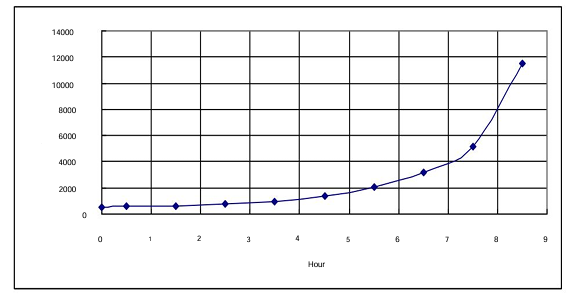
Technical Details & Test Data
- Gelation / Cure Time
Geltime measured in function of temperature
(measurement with Gelnorm Instrument/ DIN 16945/6.3.1)
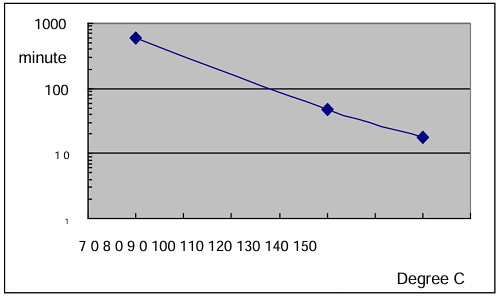
- Technical Graph
Dielectric constant (Er) as a function of temperature
(measurement frequency: 50 Hz) (IEC 56250)
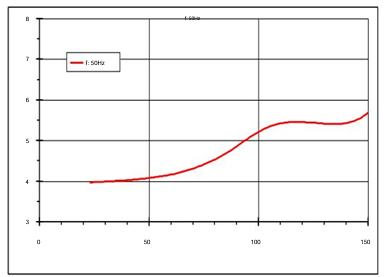
- Specific Instructions
The effective pot-life is about 2 days at temperature below 25°C. Conventional batch mixers should be cleaned once a week or at the end of work. For longer interruptions of work, the pipes of the mixing and metering installations have to be cooled and cleaned to prevent sedimentation and/or undesired viscosity increase. Interruptions over a weekend (approx. 48h) without cleaning are possible if the pipes are cooled at temperature below 18°C.
Mould temperature Conventional vacuum casting 70 - 100°C
Demoulding times (depending on mould temperature and casting volume) Conventional vacuum casting 5 - 8h
Cure conditions Conventional vacuum casting 12h at 130ÿ or 8h at 140°C
To determine whether crosslinking has been carried to completion and the final properties are optimal, it is necessary to carry out relevant measurements on the actual object or to measure the glass transition temperature. Different gel and postcuring cycles in the manufacturing process could influence the crosslinking and the glass transition temperature respectively.- Electrical Properties
Cured for 4 hours at 80°C then 10 hours at 130°C
Determined on standard test specimen at 25°C
Breakdown strength : IEC 60243-1,50 Hz kV/mm : 22 - 25
Loss factor (tan°C) as a function of temperature
(measurement frequency: 50 Hz)
(IEC 56250)
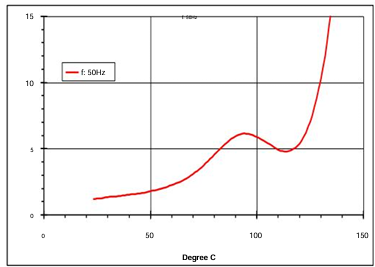
Volume resistivity (°C) as a function of temperature
(measurement voltage: 1000 V)
(IEC 60093)
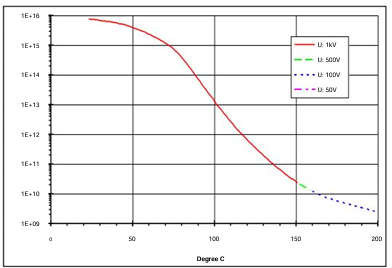
- Mechanical & Physical Properties
Cured for 4 hours at 80°C then 10 hours at 130°C
Determined on standard test specimen at 25°CProperty Test Method Unit Value Tensile strength ISO 527: 1993 N/mm² 68 - 78 Elongation at break ISO 527: 1993 % 1.8 - 2.0 E modulus from tensile test ISO 527: 1993 N/mm² 8000 - 9300 Flexural strength ISO 178: 2001 MPa 110 - 130 Surface strain ISO 178: 2001 % 1.5 - 2.0 E modulus ISO 178: 2001 MPa 8000 - 9500 Critical stress intensity factor (KIC) PM 216-1989 MPa·m¹/₂ 2.0 - 2.4 Specific energy at break (GIC) PM 216-1989 J/m² 470 - 550 Glass transition temperature ISO 11357-2: 1999 °C 65 - 80 Coefficient of linear thermal expansion ISO 11359: 1999 ppm/K 40 - 43 Mean value below Tg ISO 11359: 1999 °C 0.15 - 0.20 Water absorption (specimen: 50x50x4 mm) ISO 62 % by wt. 1.65 - 1.85 Specific Weight at 20°C ISO 62 g/cm³ 1.8 - 2.0
Storage & Handling
- Storage Conditions
Prefilled, liquid products tend to settle over time. It is therefore recommended to carefully homogenize the complete contents of the container before use. In the storage vessels of the casting equipment, the pre-filled products should be stirred up from time to time to avoid sedimentation and irregular metering.
The components have to be stored under dry conditions at 5 - 25°C, in tightly sealed original containers. Under these conditions, the shelf life will correspond to the expiry date stated on the label. After this date, the product may be processed only following reanalysis. Partly emptied containers should be closed tightly immediately after use.
